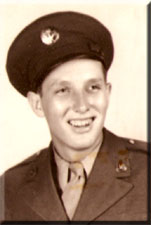
Frank Sampson's story ...
told by his neice Rosanne Mullenax:
"I never knew my Uncle but I wanted to honour his Memory ..."
Frank Herbert Sampson was born in Philadelphia. Pa to Frank L. Sampson & R. Elizabeth (Quenzer) Sampson, Feb. 27, 1926. His mother's father, Heinrich Quenzer, had come to America from Germany in the late 1800's from the same area where Frank would be killed on March 6, 1945.
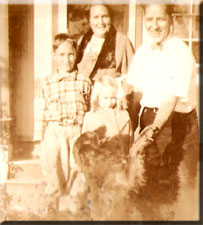

Family pic Frank his parents and sister
on the right Frank as a schoolboy
Frank H. had one sister, F. Lorraine. As a young boy, his family moved from Philadelphia to Ottsville, PA and later bought a home in Perkasie, Bucks Co. PA where family still resides. This area, they always referred to as the country. Frank always loved the country and told his family once he was in Germany that it reminded him of home.


On the left: Third Street, Perkasie PA
on the right Mood's Bridge, Perkasie, PA
Frank and my mother Lorraine were always close and he always looked out for her. They liked to play pranks on each other. I never did hear how that worked out though. He enjoyed shooting marbles and usually won except the time his sister beat him and won his favourite shooter. I have this shooter to this day. My mother always cherished it. Frank & his sister were avid roller skaters and spent many an hour at Menlo Park Roller Rink in Perkasie. Here he met his girl friend and my mother met my father, Harvey Nyce. Skating was always a big part of his life.
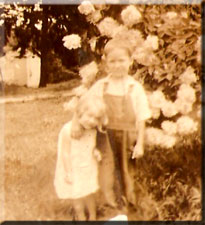
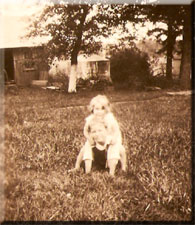
Frank and his sister Lorraine ...
"They liked to play pranks on each other"
He and the family went to church at St Andrews Lutheran Church in Perkasie. I have a sympathy letter from a Minister from SC that said Frank had attended his church and had dinner at his home while he was stationed in SC and what a fine young man he was. Frank went to school at Sellersville Perk High School in Perkasie. He worked at SKF in Lansdale, PA before being inducted in the Army.

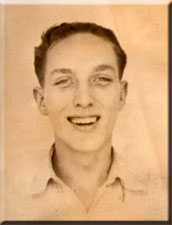
Left: Sellersville Perk High School in Perkasie, PA
Right: Frank as a teenager ...
Frank was inducted in the Army in May, 1944. He trained at Camp Wheeler, GA and Fort Jackson, SC. While at Fort Jackson, SC he wrote home and asked his family to please send his roller skates for he found a big skating rink near there. I still have this letter dated Nov 15,1944.
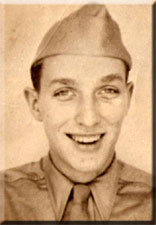

left: Frank in the US Army & right: Fort Jackson, SC
Some time in December 1944 he spent a furlough at home and he visited briefly on New Years Day, January 1st, 1945 while at Camp Meade, MD where he shipped out to Germany. He arrived in Germany some time in Jan. 1945, just 6 to 8 weeks before he was killed at the age of 19. He was with 395th Infantry Reg., 99th Infantry Div. Company G. which was referred to as the Checkerboard Division another nickname was "the Battle Babies".

soldiers from the 99th Infantry Division
attend worship services during the Battle of the Bulge
After the fury of the first week of the breakthrough in the Bulge, men of the 99th hugged their snow-filled foxholes in the open land before Elsenborn, repulsing weakening German thrusts until the division switched to the offensive in late January. Reinforced by new men from training centers in the States, the 99th received the order to advance at 0300, Jan. 30. In a concerted attack with divisions on either flank, Checkerboarders moved out through hip-deep snow for the Monschau Forest.

soldiers from the 99th Infantry Division
just outside Krinkelt (Belgium)
In early February, 1945, the division wheeled across the country through the bitterly remembered towns of Wirtzfeld, Rocherath, Bullingen, Krinkelt. CPs were set up again. Then, Checkerboarders ripped anew into the Siegfried Line, past Losheim and Hollerath and through the first belt of pillboxes to points in advance of their past drives. Battle Babies probed inner defenses when, after three months of continuous action, the 99th was relieved by the 69th Inf. Div., Feb. 13, 1945. By the last week in February, all three regiments had arrived at Aubel, which the division previously used as its assembly point before going into combat in November. It was a country of long, soft ridges, sloping pastures and wide valleys. The sun was shining and the grass in the apple orchards already green when the soldiers moved in to rest.

Troops from the 99th man their fighting positions
and wait for the next German push.
During the 10 days the 99th stayed in the area, it engaged in mild doses of training, principally for the benefit of the reinforcements, and in rehabilitation of equipment. Showers, haircuts, movies and food-pies baked by Belgian farm wives, and eggs "liberated" from farmhouse coops-featured the stay. Shortly thereafter the approach to the River Rhine followed … It wasn't easy pickings. The 394th, in the center, was slowed up in the woods below Gohr while the 395th put up a stiff scrap before taking Delrath. Artillery changed the Germans' mind about defending the town and the regiments rolled through the ruins. It was on the Rhine that the big guns of Lt. Col. John R. Brindley's 370th FA Bn., with 1st Lt. Percy J. Pace directing fire, caught two German ferries and a houseboat, sinking the craft for the division's biggest "naval" victory.
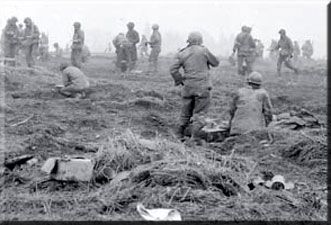
The remnants of the 393rd's 1st Battalion dig in near Elsenborn,
Belgium
the 393rd was one of the regiments of the 99th Infantry Division
Checkerboarders were the first infantry division in First Army to reach the Rhine. They moved so fast that when a phone rang at a coal briquet factory at Neurath with the home office at Dusseldorf calling to find out where the Americans were, a lineman from the 99th Div. Sig. Co. offered first hand information. Beer still was on tap where division headquarters set up its mess at a gasthaus. The Battle Babies approached so fast that Germans had time to plant only a dozen mines between the Erft Canal and the Rhine. It was during that approach on March 6, 1945 that Frank was killed. Only a day later the Ludendorff Bridge at Remagen was captured by the American forces …The irony in all this was that this was the same area his grandfather had left, years earlier and this is where Frank gave his life fighting for freedom. My grandmother & mother always said Frank loved the Army and had made many friends in the short time he was there.
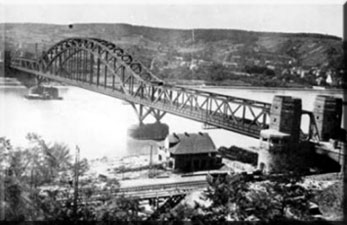
the Ludendorff Bridge at Remagen
Even though I never knew him, Franks Army picture always hung in my Grandmothers, then my Mothers and now in my home. I have not had the opportunity to travel to the Cemetery in Belgium but, some friends were there years ago and said what a beautiful place it was. They also took pictures for me that I was able to show my parents before they passed away.

Henri-Chapelle American Military Cemetery
a beautiful place to remember soldiers like Frank ...
Frank will never be forgotten. Thank you for having,
In-Honored-Glory to keep these men and women's memory alive.
Sincerely, Rosanne Nyce Mullenax

Frank Herbert Sampson ... KIA, March 6, 1945
These days my uncle Frank H Sampson rests in the beautiful American Military Cemetery at Henri-Chapelle. He is remembered and honored by me, his niece Rosanne and by his entire family. Frank is also remembered and honored by every visitor of the American Cemetery at Henri-Chapelle and by every visitor of this website.
 Private Frank H Sampson's final resting place
Private Frank H Sampson's final resting placeSpecial thanks to Frank's niece Rosanne Mullenax
published March 11, 2008